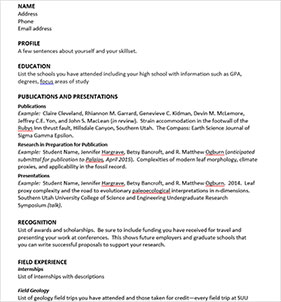Build your Geology Resume and CV
So, you want to stand out in graduate school, job, and grant applications? Doing these will prevent your application from being overlooked.
- Plan ahead and stay in contact with your professors for possible opportunities and awards.
- Maintain a GPA of 3.5 or higher.
- Prepare in advance to ensure that your GRE scores are above the 50th percentile.
- Make contact with potential graduate advisors or employers before submitting your application. National conferences are a great place to meet each other and discuss research.
- Work with your professors to develop a professional curriculum vitae/resume.
These will make your application receive more serious consideration—the more the better!
- Present your research at multiple conferences, both at SUU and nationally.
- Publish your work well before your applications are due.
- Get an internship to demonstrate your professional development.
- Obtain funding to support your research and pay for travel to conferences.
- Obtain scholarships and seek out opportunities for scholarly awards.
- Maintain a GPA of 3.8 or higher.
- Achieve GRE scores in the 75th percentile or above in any one of the three divisions: quantitative reasoning, verbal reasoning, and analytical writing.
- Attend field trips each semester to document the skills you have developed and demonstrate your investment in your professional development.
Developing your curriculum vitae/resume helps you define your future and communicate your value to graduate schools, grant committees, and future employers.
Building your curriculum vitae (for graduate applications) and resume (for professional opportunities) is where you learn how to show off all the great things you have been doing at SUU. It’s also where you get to really consider what it is you want to do and how you want to present yourself as a geologist. There are many ways to put together your curriculum vitae/resume. One size does not fit all. Let your professors look over your drafts and help you develop the best format to represent you and your work.
Deciding what to include in your curriculum vitae/resume and how to go about organizing your information can be intimidating the first time around. You will find that the structure of this document changes with each application process whether it’s for an internship, a scholarship, a grant, professional position or graduate school application. The example headings will help get you started. In each section, it is customary to list most recent events first. You won’t add some of these headings until your senior year, but the good news is that once you are satisfied with your first curriculum vitae/resume, it’s easy to update and modify to fit your evolving career.
It’s also important to supplement your curriculum vitae/resume document with a electronic portfolio resume. Don’t worry, it’s the same information, but with the added benefit of attachments including photos, documents, and even videos of your work. Linkedin.com is a great place to get started. Here you can load documents, videos, images, and web links to display your work.

